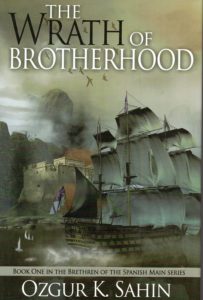Book Review: The Wrath of Brotherhood by Ozgur K. Sahin
Captain Roy Toppings had planned to live a relatively peaceful life plying a small shipping route between England and the Continent, but the murder of his sister by pirates set him on a different course, and now he’s a privateer operating out of Port Royal.
 Roy’s quest for the man who he blames for his sister’s death has to be put on hold for the moment. It seems that the Spanish are up to something big, and the Dutch colony of Curaçao is in imminent danger. Can the crew of The Constance and their new-found allies save the day?
Roy’s quest for the man who he blames for his sister’s death has to be put on hold for the moment. It seems that the Spanish are up to something big, and the Dutch colony of Curaçao is in imminent danger. Can the crew of The Constance and their new-found allies save the day?
This is the first novel by Minnesota writer Ozgur K. Sahin, and the first in a projected “The Brotherhood of the Spanish Main” pirate fiction series. The setting is the Caribbean Sea circa the Restoration of Charles II in the 17th Century.
It’s interesting to compare the character attitudes to earlier pirate-themed works I’ve read. Captain Toppings is remarkably non-sexist and -racist for his time, as well as anti-slavery a good century ahead of most people. He’s hired Ajuban, an African ex-slave, as his first mate, and soon signs on refugee Incan woman Coya as a scout. The crew is rounded out with other quirky characters, most with “nice” personalities. One character is depicted as being more romantically inclined towards Coya than she’s comfortable with, but this is shown entirely from her point of view and as of yet he has confined himself to attempting to talk to her when she doesn’t want to.
The plot breezes by with an acceptable level of coincidence, but the one concern I have is that the crew’s luck is a bit too good–one or two well-timed setbacks would have ratcheted up the tension. Perhaps this will happen in the sequel, since there’s a very obvious hook.
There is talk of torture, and it’s made clear that the privateers will resort to it if they must (there’s a minor character who does this professionally), but none occurs on-stage.
Some use of dialect is genre-appropriate, but I know it ticks off some readers.
That said, although this book was written for adults, it should be okay for pirate-loving junior high readers on up. I like the handsome hardcover edition with endpaper maps, but the perfectly acceptable ebook version is more affordable and will also help keep the author fed.
A good first novel, recommended for fans of pirate tales.

I do think it can be difficult for writers to leave out our 21st Century perspectives in historical fiction. But as I read history, I see there were people that had more altruistic beliefs. Too much ‘goodness’ though, without real anger or conflict, can be boring though. We are human after all, and that humanness is what makes literature powerful. To see weaknesses is important to transcendence. Good pirates? Ehh. I totally see your point. Maybe that’s the ‘bad’. I can steal. But I’m still a good person. ?
Generally,speaking, this is why heroic pirates in fiction are usually “privateers” who have a license to attack enemy shipping. Or steal only from bad-guy pirates, as the heroes in “One Piece” do.
I’ve always been fascinated by the concept of privateers vs pirates. It has always seemed like such a teachable moment in history where we clearly defined two equal things as different, aligning with what we decided was “good” and labeling the other as “bad.” The fact that we have done (and do) this ALL the time seems insane not to recognize.
On the TV Tropes website, it’s called “Your Terrorists are Our Freedom Fighters.” Warning: TV Tropes link. http://tvtropes.org/pmwiki/pmwiki.php/Main/YourTerroristsAreOurFreedomFighters
I find myself curious as to when this book was actually written and how popular it was at the time since there seems to be quite a bit that would be considered ‘politically incorrect’ these days and would keep certain people at bay.
2013.